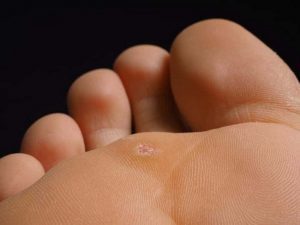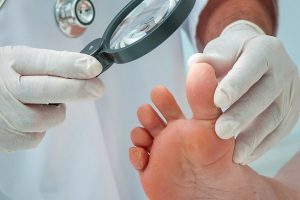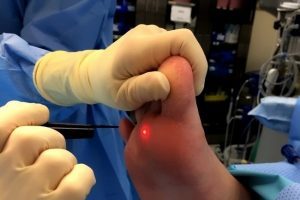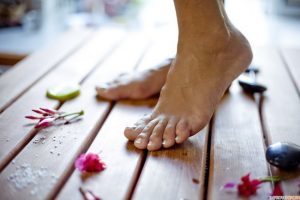Plantar warts are a product of viral skin, also known as corn. From medical terms, it is obvious that this form is located on the soles of the feet and toes. From the perspective of tumor risk, they are not dangerous, but due to painful pressure, they cause a lot of inconvenience when walking.
Causes of plantar warts
All types of warts, including plantar warts, are caused by human papillomavirus (HPV). You can get it through close contact with an infected person or daily life. The virus quickly dies from sunlight, but it feels good in high humidity. Therefore, HPV infection most often occurs in baths, saunas, and swimming pools. Minor injuries and skin cracks and reduced immunity promote the penetration of viruses into the body.
has a powerful protective effect, and the infected virus can remain dormant indefinitely. However, if the immunity declines, it will start to reproduce actively, causing various local warts on the skin. For their occurrence, the only reason is that the 1, 2, 4, 27 and 57 subtypes of HPV are the most common.
Several incentives have contributed to the emergence of this form:
- Shoes are too tight or too big;
- often wear high heels;
- Various foot deformities (including flat feet);
- Various diseases of the foot joints (arthritis, arthropathy, etc. ).
People with dry skin and hyperkeratosis are more common in leg warts.
Therefore, in all cases (HPV infection) the cause of warts is the same, but the predisposing factors are different. The number and size of the elements on the skin depend on them and the immune status.
How do plantar warts appear
The warts on the feet look like round skin growths. It can have different sizes, but rarely exceeds two centimeters in diameter. It rises no more than three millimeters above the height of the skin, but at the same time, its roots penetrate deep into the interior. The color may not be different from the surrounding skin, or darker or lighter. Generally, such structures have a yellow or gray tint. From the outside, when you look inside the element, you can see black dots or black lines (they are also clearly visible in the photo). This is the appearance of capillaries that form blood clots due to a large number of keratinous blood vessels being compressed.
First, the wart has a smooth surface. But as time passed, it became tough, rough, and thicker. It is the keratinous lump that makes these warts yellow. An important symptom of
plant warts is pain when compressed. Each step will bring severe acute pain to the patient.
These warts are very similar to plantar calluses. Due to the two forms of severe pain, the similarity with the cornice is particularly obvious. The main difference is that there is no skin pattern on the surface of the wart, while it remains on the calluses.
Diagnosis of plantar warts
A qualified dermatologist will diagnose the disease based on only one clinical picture. In some cases, additional dermoscopy is required.
There is no skin pattern on the formed skin, and there are capillaries with blood clots in its structure.Planar wart treatment

Plant warts are more difficult to remove than similar structures in other regions because they penetrate deeper into the dermis. For smaller newly formed elements, necrotic external agents can be used. Large and deep warts are removed by surgery. At the same time, keratolytic agents should be used to soften the old rock formations.
External preparations for wart removal
In some cases, these structures may self-destruct. However, because the warts are very hurt, the patient does not want to wait and try to get rid of them as soon as possible.
Prescribes the treatment of any plant wart with necrotic effect to remove small and superficial elements.
The acid contained in these products will coagulate skin proteins and cause necrosis. Medicines containing refrigerants have a similar effect. But they cause necrosis through tissue freezing rather than chemical damage.
All these drugs are applied to the formation point by point. It must be strictly monitored that the substance does not fall on the surrounding tissues, as this will cause them to burn. After treatment, the wound will remain in the original wart area and cover it with a hard skin. After healing, it will fall off on its own. You can do this type of treatment at home, but only under the guidance of a doctor.
In this way, a wart that is only small in size and penetrates the skin in a shallow layer can be removed. For larger elements, you need to choose other removal methods, because incomplete destruction of the wart tissue will definitely lead to its recurrence.
Surgery method to remove plant warts

There are many ways to remove warts during surgery. It is best to use the soft method:
- Laser removal;
- Radio wave knife;
- cryodestruction;
- Electrocautery
All these procedures are carried out in the clinic. Patients can go home within a few minutes after completing the operation. They only need to treat the wound regularly at home.
The most effective and safest way to remove plant warts is to use a laser or radio wave knife. During these operations, blood vessels will immediately clot, which can prevent bleeding and secondary infections. The use of these methods to remove the complications of skin formation is very rare. There are different opinions about freezing destruction and electrocoagulation, so these treatments have faded out of the background and are rarely used.
If the wart is large or large (covered by a large amount of keratinous mass), it is recommended to treat it with a keratolytic agent two weeks before the removal operation. For this reason, drugs such as salicylic acid ointment or acid are prescribed. Therefore, a part of the horny scale can be removed, making the stratum softer and softer.
This makes it easier and faster to remove warts.In rare cases, if there are many elements or there are doubts about their nature, the doctor may recommend surgical removal with a scalpel. With this method of removing warts, the recovery period and the high risk of scar formation are much longer, so it can only be used under strict indications.
Features of plantar warts in children
Plant warts are common in children over five years of age because they often run barefoot, get injured and do not always follow personal hygiene rules. Due to frequent contact with sick children (in kindergartens and schools), the immune function malfunctions, which increases the possibility of warts.
It is best to treat this form of children from external factors. You can try to use salicylic acid ointment, and then use pumice stone to exfoliate superficially. Immunomodulatory drugs have proven themselves very good. When they regularly apply it to the wart, they can remove it within a few weeks.
If the element is very deep, use necrotic agent or use a laser or radio wave knife to remove it.
Prevention of plantar warts

It is absolutely impossible to protect yourself from the occurrence of warts, but you can reduce the occurrence of warts. For this, you need to act in two directions: eliminate the predisposing factors and stimulate the body's defenses.
To achieve the first goal, you need:
- Follow personal hygiene rules (do not walk barefoot in public places, wash your feet every day and treat wounds and wounds in time);
- Choose comfortable shoes according to the size;
- Promptly prevent foot deformities and treat joint diseases.
A healthy lifestyle, participating in sports, exercising, taking vitamin complexes and doctor-prescribed immune-stimulating drugs will help maintain the body’s defenses at a good level.
If the skin is excessively dry and hyperkeratotic, it is recommended to perform a medical pedicure and peeling regularly. If your legs sweat too much, you need to use special methods to treat hyperhidrosis. Following all these rules, the risk of warts on the soles of the feet will be minimized.
Plantar warts are not a dangerous disease, but they can cause a lot of inconvenience due to the pain when walking. Fortunately, there are many methods in modern medicine that can quickly eliminate this disease and minimize the risk of new recurrence. For this, you need to consult a dermatologist and strictly follow all his appointments and recommendations.














































































